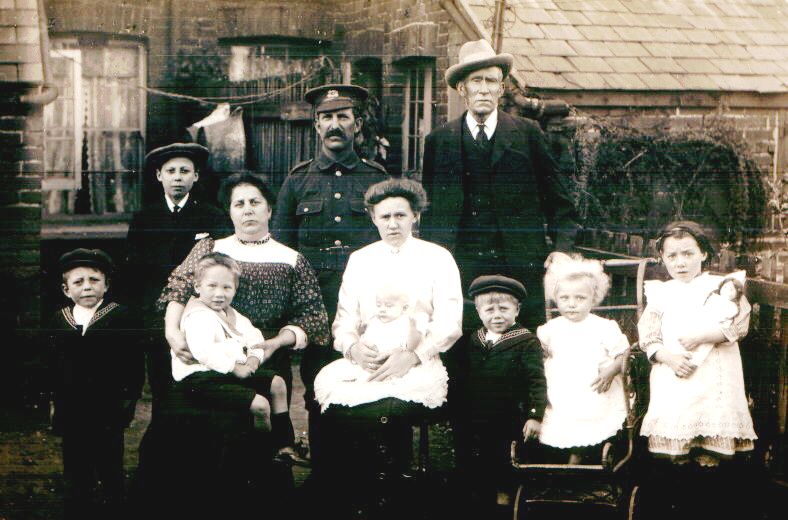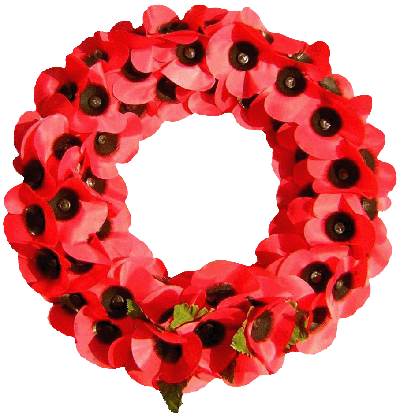John French
Private 5531 John French, 2nd Battalion Royal Berkshire Regiment
John was born in 1878, the son of James French and his wife Eliza née Lawrence, he was their youngest son though they had one younger daughter. The full list of his siblings include: Sarah Ann (born 1867), Elizabeth (1869), William (1871), Caroline (1872), twins Mary Ann & James (1876) and Eliza (1881).
On 26 January 1899 John, aged 19 years and 7 months, enlisted with the 3rd Battalion of the Royal Berkshire Regiment; he was 5ft 3ins tall with a fresh complexion, grey eyes and brown hair. Evidence of an earlier trauma was a 4in burn scar above his left ankle. Prior to his enlistment he had been working as a carter for a Mr Purdue, possibly Arthur Purdue a corn dealer with premises in the Market Place.
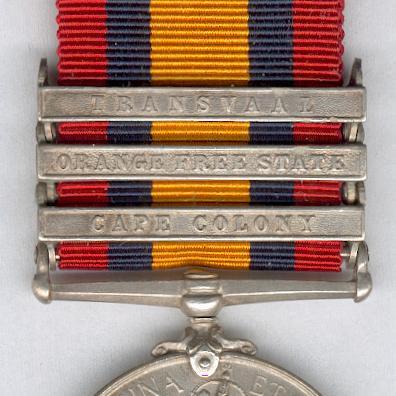
Campaign clasps on a Queen's South Africa Medal |
His enlistment was as a militiaman for a period of six years; however, later in 1899 the Boer War started and it seems that he converted from the militia to regular soldiering. He was posted to the Royal Berkshire Regiment’s 2nd Battalion in Cape Colony. An account of the battalion’s involvement in the war can be found on at AngloBoerWar.com. For his involvement John was awarded the Queen’s South African Medal with campaign clasps for Cape Colony, Orange Free State and Transvaal. He also received the King’s South Africa Medal (Queen Victoria died during the confict) with clasps for 1901 and 1902.
In 1907 his period of enlistment with the colours was completed and he returned to civilian life, almost certainly with a continuing commitment to the regimental reserve, probably until 1911 (a combined regular/reserve term of 12 years was the norm). He found work as a builder’s labourer and a wife, Elizabeth Annie Hazell, whom he married in 1908. Their first child, John William, was born 2nd March 1909 followed by Alfred Edward on 9th November 1910, Ellen (Nellie) in 1912 and Winifred (Winnie/Wynne) in 1914. The family lived at 4 Gordon Terrace, King's Road.
When war arrived in August 1914 John was soon back in uniform. Even though his service had been completed some years earlier he was back with the 2nd Battalion, Royal Berkshire Regiment, when it crossed the Channel to France on 5/6 November 1914. It appears that he had extended his service in the Reserve battalion of the Royal Berks (Reserves could extend their service by an additional 4 years). The army offered a valuable incentive in the form of 3s 6d a week pay for virtually no committment - unless a war broke out.
When war was declared the 2nd Battalion was in India; it was quickly brought back to the UK where it combined with other units returning from garrison duties around the Empire to create the 25th Infantry Brigade, a part of the 8th Division. The 8th Division took part in the first British offensive of the war at Neuve Chappelle in March/April 1915 and the Battle of Aubers in May after which they had a quiet period (if being part of a Division manning the trench line can ever be called ‘quiet’). In late September the next major offensive was planned in the French coal-mining area around Loos-en-Gohelle. Two battalions of the Royal Berkshire Regiment, the 1st and 5th were to take part at the centre of the offensive; the 25th Brigade, including the 2nd Battalion, was to carry out a diversionary attack at Bois Grenier to the north of Loos coinciding with the launch of the main offensive on 25 September 1915.
The war diary entry for the day is terse:
War Diary – 2nd Battalion Royal Berkshire Regiment
France, BOIS GRENIER: The Battalion took part in an attack on the German position and during the day sustained the following casualties:- Officers killed : CAPTAIN RWL OKE, CAPTAIN WA GUEST-WILLIAMS, LIEUTENANTS GF GREGORY, RHG. TROTTER, J VESEY, RHL SIMMONS and 2nd LIEUT B RUSSELL. Officers wounded: CAPTAIN GH SAWYER, LIEUT GE HAWKINS, 2nd LIEUTS HFR MERRICK, R LEWIS, and GW LINDLEY. (The last two names were not admitted to hospital). Other Ranks: Killed 32, Missing 143, Wounded 216. For the report of the operation, see Appendix III. “ Report by LIEUT-COLONEL GPS HUNT, commanding 2nd Royal Berkshire Regiment.” 1 man admitted to hospital sick.
Sadly John French was one of the 165 ‘other ranks’ listed as killed or missing. The War Diary appendices for the month’s activities give a lot more detail – too much to repeat here.
The official history covers the action in little more than a page:
Military Operations - France & Belgium 1915 (Vol 2 p262-3)
ACTION AT BOIS GRENIER – 25 September
The attack by the III Corps (Lieut-General Sir W P Pulteney) on the left of the Indian Corps, was carried out at 4.30am, by the 8th Division (Major-General H Hudson) without gas, but with smoke to cover the flanks, from the neighbourhood of Bois Grenier (south of Armentières), which gives its name to the action. It was preceded by a bombardment on the previous day and five minutes short, sharp fire.
The general idea of the operation was to push through towards Fournes and eventually affect a junction with the Indian Corps on Aubers Ridge. Three battalions of the 25th Brigade (Br-General R B Stephens), the 2/Rifle Brigade (Lieut-Colonel F H Nugent), 2/R Berkshire (Lieut-Colonel G P S Hunt), and 2/Lincolnshire (Lieut-Colonel S Fitz G Cox) assaulted the German position on a frontage of 1,200 yards, between Corner Fort and Bridoux Fort, two works in the German front line. The attack started promisingly. The front trench, including both Corner and Bridoux Forts, was carried in the first rush, and 3 officers and 120 men of the 16th Bavarian Reserve Regiment were taken prisoner. The Lincolnshire, on the left, pressed on and took a considerable length of the support trench. At one part only, a front of three hundred yards at the junction of the lines of the Rifle Brigade and the Berkshire, was the attack held up, machine guns in Angle Point, a small work in the front line, repulsing all assaults. After the first rush the Germans on the flanks and in Angle Point maintained a continuous fire on No Man’s Land, so that reinforcements with ammunition were unable to cross it. At 1pm a determined counter-attack drove back the Lincolnshire on to Bridoux Fort, and shortly afterwards German bombers forced them back from the captured front trench, the survivors, together with two companies of the 1/R Irish Rifles (Lieut-Colonel R A C Daunt), which had come up in support, withdrawing along the dykes to their original starting trenches. By 2pm the position of the Berkshire, now hard-pressed on both flanks, both from Bridoux Fort and Angle Point, also became untenable, and Colonel Hunt ordered them to withdraw to their original trenches. At Corner Fort the right of the Rifle Brigade continued to hold on and beat off several counter-attacks, two trench mortars brought up into the work assisting greatly in keeping off the German bombers*. It was felt, however, that the retention of this isolated position would not be worth the losses it would entail, and at 3.30pm the defenders were ordered to withdraw, the movement being skilfully carried out with little loss. Advantage had been taken during the attack to dig a new trench, which was completed during the night, across the re-entrant in the British line at this point, thereby reducing the frontage considerably and cutting out a weak point in the sector.
* Bombs = hand grenades
The Division's casualties were 52 officers and 1,283 other ranks. Locally the only positive result was a small shortening of the British lines; strategically the action may have diverted some German reinforcements away from the main action at Loos. Not a lot to show for so many casualties. For a detailed account of the 2nd Battalion’s activities that day click.
John’s body was never identified so he has no known place of burial; his name is remembered on the Ploegsteert Memorial a few miles north of Bois Grenier, alongside Ploegsteert wood, known to the Tommies as Plugstreet Wood.
The news reached Newbury a couple of weeks later:
Newbury Weekly News, 14 Oct 1915, p8 – Local War Notes
The sad news has been received that Pte John French, of Lisworthy, Gordon-road, has been killed in action in France. He was an old soldier, having served for eight years with the 2nd Royal Berks before the European War broke out. During this time came the South African War, and he was fortunate in going through a great deal of fighting without injury. For this service he was awarded the King’s medal with two bars, and also the Queen’s medal with three bars, in which was inscribed Transvaal, Orange Free State, and Cape Colony. At the declaration of peace, Pte French finished his eight years in Egypt. On August 4th, 1914, he was recalled to the colours, and six weeks later left with the 2nd Royal Berks for France. For 12 months he had endured the hardships of trench warfare, and a few days ago his wife received the sad news of his death from a comrade of his regiment. Though no official notice has been published, yet the fatality seems to be true, for an extract of his comrade’s letter reads thus: “Your husband was killed in the recent action in which the battalion took part, and fell close to the enemy’s trenches, but he did not suffer any pain for his death was instantaneous. He was a great chum of mine and I miss him very much.” The deceased soldier leaves behind a widow and four young children. Mrs French has also two brothers-in-law and three nephews all on foreign service.
In the same paper John’s wife had a notice inserted in the Family Announcements column:
Newbury Weekly News, 14 Oct 1915 - Killed in action
FRENCH – Recently in France, killed in action. Pte John French, 2nd Royal Berks, dearly loved husband of Elizabeth Annie French of Lisworney, Gordon-road, Newbury, aged 35. – “Deeply mourned.”
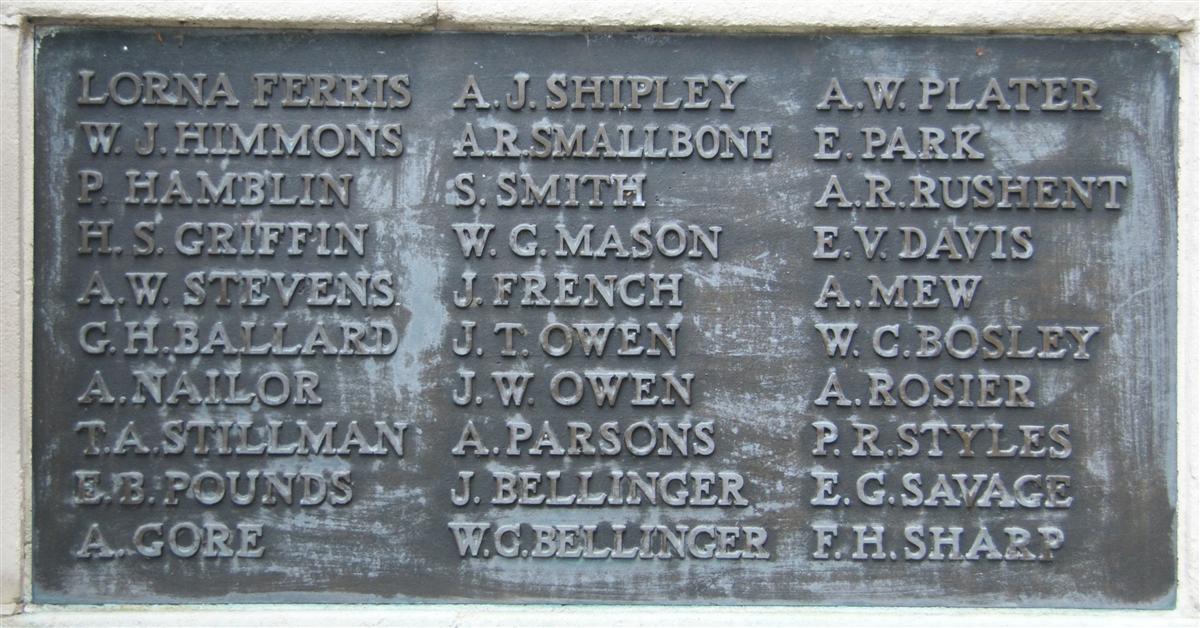
John French's name on Newbury War Memorial (centre) |
It appears that this announcement was made before the exact date of John’s death was known; three weeks later another notice appeared:
Newbury Weekly News, 4 Nov 1915 - Killed in action
FRENCH – Sept 25, killed in action in France. Pte John French, 2nd Royal Berks, dearly loved husband of Mrs Elizabeth Annie French of Lisworney, Gordon-road, Newbury, aged 35. – “Deeply mourned.”
Locally he is remembered on Tablet 1 of the Newbury Town War Memorial.
John's widow, Elizabeth, remarried in 1916 to Jonathan Green, a 43 year old goods porter who worked for the Great Western Railway (from the windows of Lisworney, their cottage in Gordon Road, they looked out over the GWR line through Newbury). Later they moved to Kew Villa, Buckingham Road, the address recorded by the Commonwealth War Graves Commission for Elizabeth (they often have addresses from the 1920s, when medals were distributed).
But John was not forgotten:
Newbury Weekly News, 2 October 1919
- In Memoriam
FRENCH – In loving and affectionate
remembrance of Pte J French, 5531, 2nd Royal Berkshire
Regiment, killed in action at the Battle of Loos, September 25th,
1915.
Four years have passed, our hearts still
sore,
As time goes on we miss him more.
Sleep on, dear Jack, in a foreign grave,
Your life for your country you nobly gave.
No loved ones were with you to say
‘good-bye,’
But safe in God’s keeping you nobly lie;
His warfare over, his battle fought,
His fresh young life could not be saved;
He slumbers now in a soldier’s grave.
RIP – Still fondly remembered by all
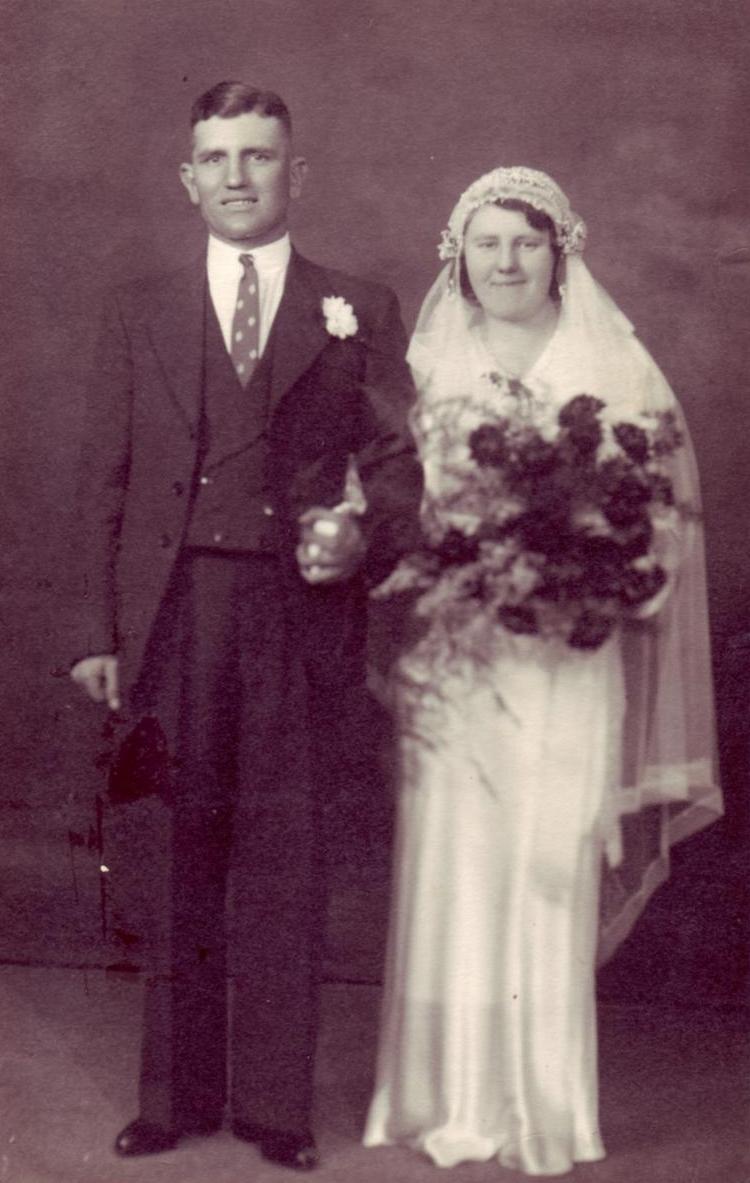
Harry (Shackie) Withers and his wife, John French's daughter Wynne (Brian Withers) |
The baby in the family picture (above) is Winnie French, John and Elizabeth's youngest child. Winnie married Harry Withers, known as 'Shackie', in 1935; Harry was in the Oxfordshire and Buckinghamshire Light Infantry when another British Expeditionary Force was sent to France and Belgium in 1939. He died fighting in a rearguard action protecting the beaches at Dunkirk in May 1940. He is remembered on the WW2 tablets on Newbury Town War Memorial.
Thanks are due to:
Karen Newbery for her help researching the family.
Julian French, John’s great grandson, for his contribution and the photograph of the family. Julian’s account of his experiences discovering his great grandfather’s story is told here.
Brian Withers for information about and photographs of 'Shackie'.
